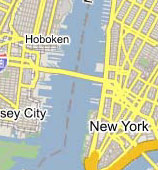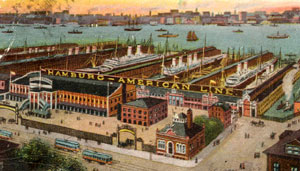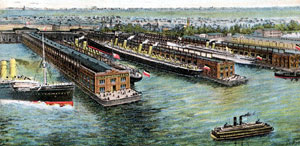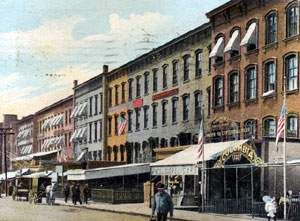The City of Hoboken , Hudson County , New Jersey (part of the Port of New York)
 Hoboken
and all of Hudson County started, grew, and developed beginning with the middle
of the nineteenth century.The main reason for this rapid growth was the town's
proximity to New York City. Hoboken is directly across the Hudson River from
downtown Manhattan. Early in thenineteenth century the first ferry service
started from New York to Hoboken, thus starting the development of the Town
of Hoboken and its waterfront. At first, the town was a resort location for
New Yorkers,
Hoboken
and all of Hudson County started, grew, and developed beginning with the middle
of the nineteenth century.The main reason for this rapid growth was the town's
proximity to New York City. Hoboken is directly across the Hudson River from
downtown Manhattan. Early in thenineteenth century the first ferry service
started from New York to Hoboken, thus starting the development of the Town
of Hoboken and its waterfront. At first, the town was a resort location for
New Yorkers, but it later became a commercial center and railroad hub. Due to its mile
long waterfront, many major transatlantic shipping companies built piers for
European shipping.
but it later became a commercial center and railroad hub. Due to its mile
long waterfront, many major transatlantic shipping companies built piers for
European shipping.
New York became the largest immigration port in the United States in the nineteenth and early twentieth century. As several German steamship lines had their docks in Hoboken, many cabin passengers took the first steps of their new lives there. Steerage passengers were required to clear immigration into the United Sates at either Castle Garden or Ellis Island, but each was no more than two miles and a five-cent ferry ride away from Hoboken.
 Hoboken
was dominated by Germans in the latter part of the nineteenth century and
the first half of the twentieth century, so the town was a good starting point
for German immigrants. Many boarded trains to other parts of the United States,
but others stayed and called Hoboken home for generations to come.
Hoboken
was dominated by Germans in the latter part of the nineteenth century and
the first half of the twentieth century, so the town was a good starting point
for German immigrants. Many boarded trains to other parts of the United States,
but others stayed and called Hoboken home for generations to come.
Hoboken was and is a city built with many substantial three-, four-, five-, and six-story brick buildings. Usually the first floor was a commercial space, with residential apartments on the upper floors. This was just right for these new immigrants, who would often rent a room from a German family living in a five- or six-room apartment.
Many whole families did not come to America at the same time. Husbands and fathers would often come first, followed by the rest of the family after the head of the household found employment. This process sometimes took several years. When a family became established, members of the extended family would sometimes immigrate. Hoboken was a commercial and manufacturing center and there were many jobs available for both skilled and unskilled labor. It was a good place to live and work.
 Hoboken
was ethnically German in the first part of the twentieth century. The Germans
were politicians, business owners, craftsman, and laborers. There were German
churches, clubs, restaurants, sports, and beer halls. For sure, this was a
good new hometown. The first major change to this life came with World War
One. In Hoboken, and throughout the United States, Germans were looked upon
with suspicion. But the new German Americans served their new county well
in the military, and in their jobs on the railroads and defense plants and
by purchasing Liberty Bonds. Hoboken was so German that even through World
War One and Two and into the 1960's the school board meetings were conducted
in the German language and the minutes were written in German.
Hoboken
was ethnically German in the first part of the twentieth century. The Germans
were politicians, business owners, craftsman, and laborers. There were German
churches, clubs, restaurants, sports, and beer halls. For sure, this was a
good new hometown. The first major change to this life came with World War
One. In Hoboken, and throughout the United States, Germans were looked upon
with suspicion. But the new German Americans served their new county well
in the military, and in their jobs on the railroads and defense plants and
by purchasing Liberty Bonds. Hoboken was so German that even through World
War One and Two and into the 1960's the school board meetings were conducted
in the German language and the minutes were written in German.
Hoboken was and still is a new home to many immigrant groups: Germans, 1850 - 1910; Irish, 1870 - 1910; Italians, 1920 - 1935; Hispanics, post-World War Two; Asians, 1970 to date. Additionally, many Southern Blacks came north after our Civil War looking for a better life. Most of these immigrants found better lives in Hoboken.
The Hoboken Immigrants move on!
Immigrants who moved into Hoboken were looking for a better life and most
found it. For many this was defined by moving to a finer apartment in Hoboken
or saving enough money to buy their own home. Immigrants in Hudson County
moved from town to town rather often as their financial situation or their
job location changed. Few immigrants held a job for life, as they were looking
to climb the ladder of success. So as a new language was learned and better
trades were found it was sometimes necessary to move. Hudson County, New Jersey
is only about 19 square miles, so a move to another town within the county
was not a major event. It was generally looked upon as a move to a better
neighborhood, but it was still close to their hometown Hoboken. Hoboken being
very urban, as is all of Hudson County, many second-generation families looked
to find a better life by moving to the suburbs. With better roads and more
automobiles after World War Two, the move away from urban areas was rapid.
This meant a long commute for work, as businesses were still in the cities.
In the 1980's, a move back to the cities began, breathing new life into Hoboken
and many American cities.
Hoboken is still a city of immigrants, but with a decidedly up-scale look.
Would our immigrant forbears of the early twentieth century still recognize
their town? Yes, the substantial brick buildings are still there, but the
manufacturing and industrial buildings have been turned into luxury apartments.
The ferry terminal has ferries again, and the commercial buildings have stores
and restaurants, but the German beer gardens and delicatessens are gone. Hoboken
is still the town that the Germans helped to build.
© Alan Prellberg, September 2007
________
PS.
You will find a lot of old phoptographs and postcards as well as adequate
discriptions on Maggie Land Blanck's website www.maggieblanck.com/Hoboken/Hoboken.html
. Within her report there is an extra article on the Hoboken
Piers. Besides, the website offers background to her own family's immigration.
The photos adapted from Maggie's collection show Hamburg American Line Piers,
North German Lloyd Piers and the waterfront Riverstreet, all Hoboken.
(P.T)